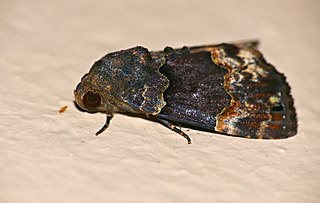
Arrade is a genus of moths of the family Erebidae described by Francis Walker in 1863.

Avitta is a genus of moths of the family Noctuidae described by Francis Walker in 1858.

Bocula is a genus of moths in the family Erebidae. The genus was erected by Achille Guenée in 1852.

Catada is a genus of moths of the family Erebidae. It was first described by Francis Walker in 1859.
Chlumetia is a genus of moths of the family Euteliidae. The genus was erected by Francis Walker in 1866.
Chusaris is a genus of moths of the family Erebidae. It was erected by Francis Walker in 1859.

Dinumma is a genus of moths in the family Erebidae first described by Francis Walker in 1858.
Dunira is a genus of moths of the family Erebidae. The genus was erected by Frederic Moore in 1885.

Egnasia is a genus of moths of the family Erebidae. The genus was first described by Francis Walker in 1859.

Hadennia is a genus of moths of the family Erebidae. The genus was erected by Frederic Moore in 1885.

Homodes is a genus of moths of the family Erebidae first described by Achille Guenée in 1852.

Hypenagonia is a genus of moths of the family Erebidae first described by George Hampson in 1893. The adult moths have pale brown wings with a dark band across each wing. The wingspan of these moths is about 1 centimeter.

Hyperlopha is a genus of moths of the family Erebidae. The genus was erected by George Hampson in 1895.

Lysimelia is a genus of moths of the family Noctuidae. The genus was erected by Francis Walker in 1859.
Mecodina is a genus of moths of the family Erebidae first described by Achille Guenée in 1852.
Oxygonitis is a monotypic moth genus of the family Noctuidae. Its single species, Oxygonitis sericeata, is found in the Indian subregion, Myanmar, Sumatra, Peninsular Malaysia, Java, Borneo, the Philippines, Sulawesi, Australia and Sri Lanka. Both the genus and species were first described by George Hampson in 1893.
Stictoptera is a genus of moths of the family Euteliidae erected by Achille Guenée in 1852.
Tadaxa is a genus of moths of the family Erebidae. It was described by Nye in 1975.

Targalla is a genus of moths of the family Euteliidae. The genus was erected by Francis Walker in 1858.
Brana is a monotypic moth genus of the family Noctuidae. Its only species, Brana calopasa, is found in Sri Lanka and Australia. Both the genus and species were described by Francis Walker, the genus in 1858 and the species in 1859. It It is a serious pest on Berrya cordifolia.












